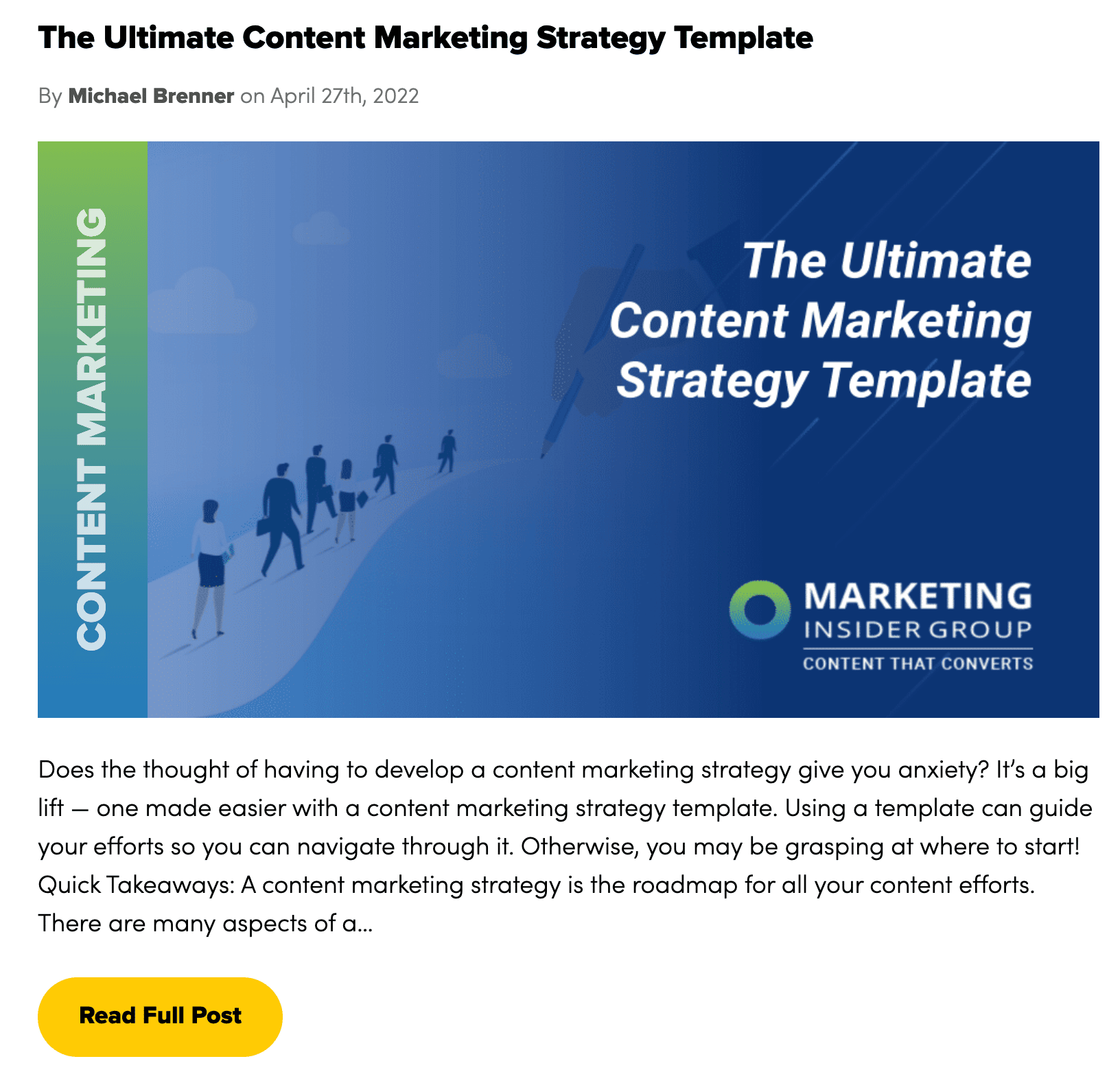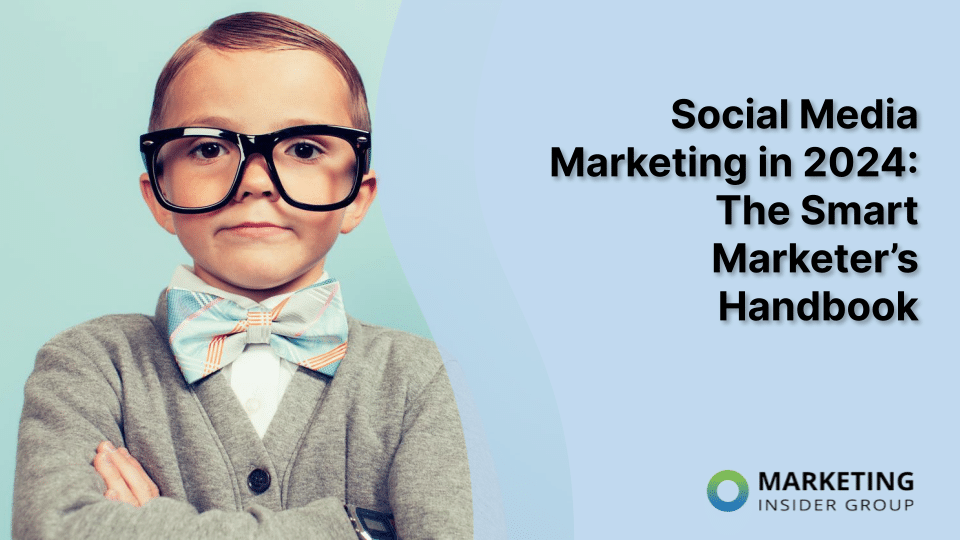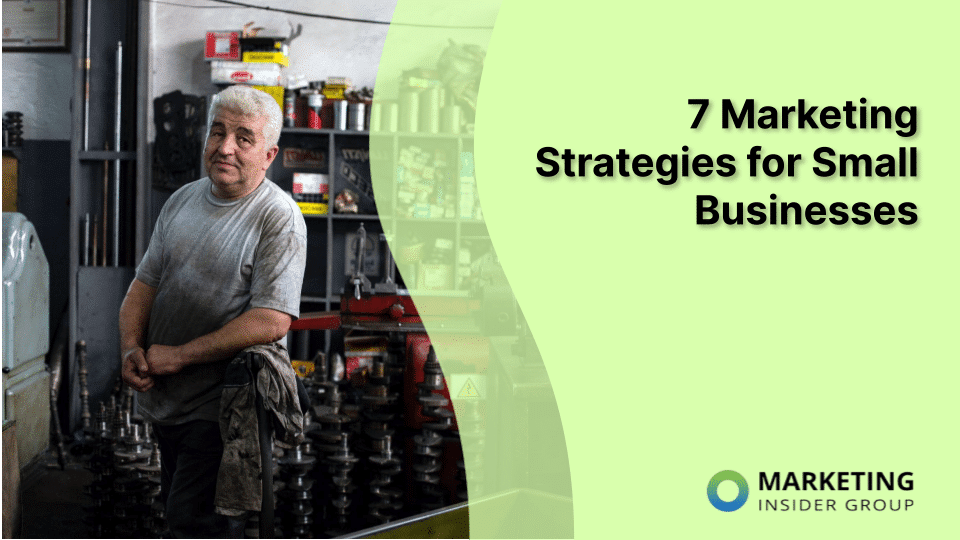
7 Smart Marketing Strategies for Small Businesses
Whether you’re launching a new small business or already have an existing one, you need to develop a marketing strategy that prioritizes a strong online presence. With 97% of people researching local businesses online, it’s essential to meet potential customers where they spend the most time.
However, growing your small business in the digital landscape isn’t easy. Between defining your target audience, promoting your services, and getting the word out, it’s simple to understand why you’d be overwhelmed.
Throw developing a marketing strategy into the mix, and it might seem like you’re trying to learn a foreign language.
Don’t worry! With the right strategies and channels in place, you can get on the fast track to growing brand awareness and earning ROI. In this post, let’s discover what should be at the center of your small business marketing strategy.
Quick Takeaways:
- A marketing strategy helps you optimize your online assets and promote your company.
- You need to develop your audience, value proposition, and technology before diving into digital tactics.
- The right strategy combination—search engine optimization, social media, etc.—will help you earn brand awareness and conversions quickly.
PS – I put together these 10 tips for optimizing your content marketing. Watch Now!
Why is it Important to Build a Small Business Marketing Strategy?
Every business wants to get their name out there, but when you’re a small business with a modest budget, it’s hard to come up with traditional and online marketing ideas while balancing marketing expenses against the expenses of actually doing business. And with advertising costing as much as it does, it’s no wonder that so many small businesses struggle to get noticed.
Here’s the plot twist, though: advertising isn’t the best way to generate leads anymore. The average person today sees around 5,000 ads a day, a number that’s over twice as high as it was in the ‘80s. As a result, ad blockers are now used by more than 250 million people. So if ads aren’t the way to build a customer base, what is?
Well-researched and planned digital marketing, diligently and consistently executed will keep the branding and sales wheel churning for the smallest of businesses.
Did you know that 50% of small businesses don’t have a dedicated digital marketing strategy? Small businesses often deal with a limited marketing budget. As a result, it can be a challenge to earn visibility in a local community.

A marketing strategy helps you increase brand awareness and develop a pipeline of qualified leads that will turn into sales. With the right digital tactics in place, you can scale your small business marketing efforts to earn more customers in your local area.
Before diving into your channel strategies, you need to build a foundation. Consider the following elements when getting started:
- Understand your target audience’s problems and priorities so you can present your business as the solution
- Build a strong value proposition that differentiates you from your competitors
- Set performance goals so you can focus your budget and resources on meeting objectives
- Identify how you can leverage current customers to become your brand advocates
- Use free promotional tools and automation where applicable
Can Small Businesses Compete Against Enterprise Behemoths?
Small businesses are the lifeblood of the economy. In the United States, small businesses make up over 99% of all employer firms and accounted for 63% of net new jobs created between 2013 and 2023.
Why am I telling you this? Because for some strange reason, when we think “economy” we think of the Amazons, Googles and Apples of the world. Not one thought is spared for the businesses that actually employ almost the whole country. Remember, every President and wannabe President has cried out, “Small businesses are the backbone of the American economy.”
However, even though small businesses play such a vital role as employment generators, they lag far behind the large companies in terms of business value created. Despite employing way more people, small businesses accounted for just 46% of total private sector output and just a third of all exports.
This means the behemoths of the world are doing something right that’s leaving the minnows eating dust. Does this mean there’s no way for a small business to compete against the Goliaths? Absolutely not! It depends to what extent you can replicate their marketing strategies successfully.
Components of a Small Business Marketing Strategy
There’s no secret sauce to developing a small business marketing strategy. However, the below strategies can help small businesses earn high ROI, and even get some valuable time back.
While the combination might be trial and error, dedicating time and budget to your marketing will pay off in sales and brand reputation.
1. Search Engine Optimization
Beyond developing an impressive website, search engine optimization (SEO) is perhaps the most impactful marketing strategy for small businesses. SEO is the process of optimizing your website and content for search engines or end users to find your company easily.
Often, the higher you rank on Google, the more likely you’ll be able to drive traffic and consumers to your website. With over 35% of all traffic coming from local sources, customers searching for your services will be more likely to find your business in search engine results.
You can implement SEO by:
- Creating a Google My Business account
- Requesting reviews from your customers
- Optimizing your website with local keywords
- Creating blog posts or videos that relate to the local community
- Using location pages
- Focusing on getting high-quality backlinks
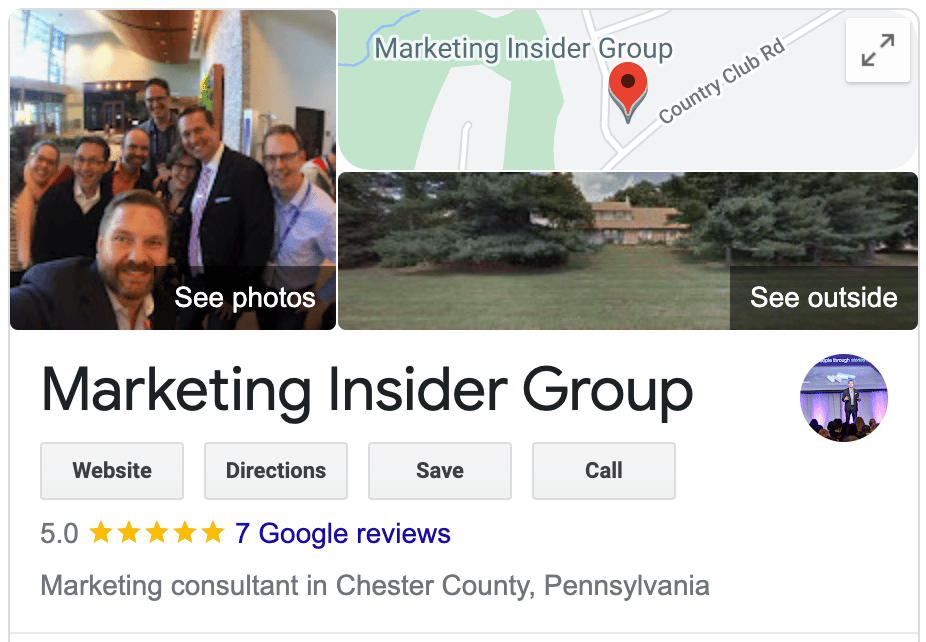
At Marketing Insider Group, we’re constantly optimizing our strategy for ourselves and for the clients we serve.
The best advice we can give to any small business is to publish blog articles multiple times per week. Even if you don’t have the bandwidth to do it all right now, start small! Check out our guide to writing the perfect blog post and skip right on over the trial and error of blog posting.
Don’t expect to write a few words on an industry trend or two and expect your website to crash from too many visitors! Research SEO blog posting strategies and others that could help to build your credibility in search.
PS – Check out our weekly blog content service to grow your website traffic and leads!
2. Pay-Per-Click Advertising
Pay-per-click (PPC) advertising allows small businesses to display ads when consumers search for certain keywords in a search engine. While it can lead to an expensive bidding war, local markets are often less competitive and the PPC model helps you keep a regulated budget.
Sounds good, right? But, how does this work?
You bid on certain keywords—like “local printing company” or “office supplies near me”—and create ads around those phrases. Advertising platforms will then use an algorithm to display your ads in the search engine result pages (SERP) based on factors such as keyword relevance and landing page quality. You pay every time someone clicks on your ad.

For some, it works wonders. But this must be a thoughtful approach! Definitely don’t just “throw money at the problem.” Make sure your business roots are strong, like your strategy, website, and brand messaging. Then assess if PPC advertising could truly make a difference for you.
3. Email Marketing
With a projected 4.3 billion email users by the end of 2023, email marketing is an excellent way for you to reach your target audience. In fact, 81% of small businesses report that email is their primary lead generation and retention tool.
Email marketing is the only digital marketing tool that allows you to build a personalized relationship with customers and continue to nurture them well after their first purchase. You can send customers drip campaigns based on an action—like signing up for a consultation or completing a purchase—or send regular newsletters filled with company and product updates.
To use email marketing successfully, consider the following tactics:
- Segment your customers based on demographics or activity
- Use a CRM or EPS to automate sending emails at the right time
- Develop compelling subject lines to make sure your email gets clicked
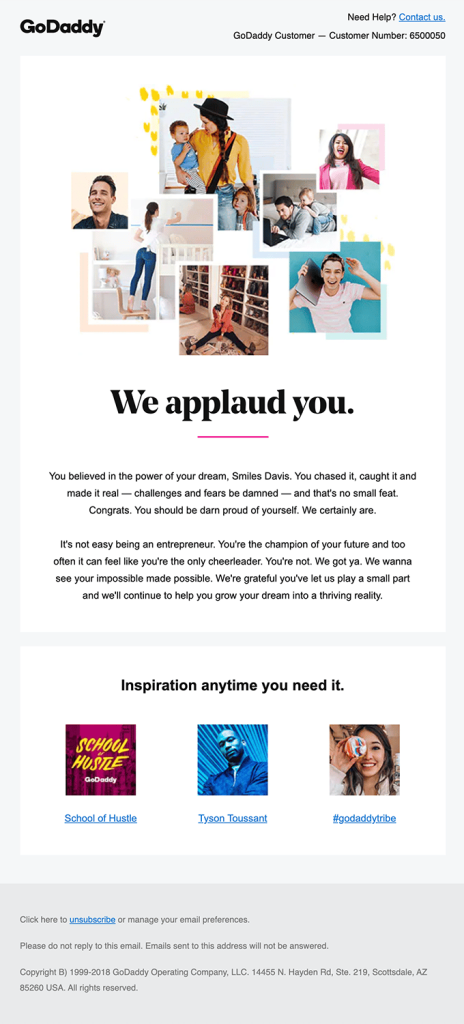
4. Social Media Marketing
If you’re looking to reach a larger audience and engage with customers regularly, social media is a small business must-have. While it may not be the biggest driver of sales growth, it can help you reach awareness and branding goals.
The average user spends 3 hours a day on social media. While it may seem intimidating at first, it’s essential not to spread yourself too thin and join every platform.
Instead, focus on your target audience. Where are they spending the most time? What type of content do they enjoy? How can you make the biggest impact?
Depending on your customer needs, consider the following platforms:
- Facebook: Post entertaining pictures, status updates, and customer success stories
- Twitter: Share news and answer customer inquiries in real-time
- Pinterest: Spread visual content like blogs, infographics, e-books quickly
- YouTube: Dominate with user-generated and branded video content
- Instagram: Display high-resolution imagery that showcases your services

But remember this important detail: showing up on social media platforms when you feel like it is not enough!
Your small business’s social media accounts could use their own smart strategy. Once you’ve figured out where your audience is lurking, build a realistic content plan and publishing schedule. Stay consistent for a few weeks and don’t be afraid to make small adjustments along the way.
5. Content Marketing
What should be at the center of your small business marketing strategy? Content marketing.
Content marketing is the act of developing and publishing high-quality content that is valuable to your target audience. It should speak to their challenges and needs while positioning your business as the solution through creative storytelling.
It’s important to note that content marketing is a long-term strategy. It will take significant time to build rapport with your customers and search engines. However, when done correctly, content marketing can position your business as an industry leader and build long-lasting relationships with your audience.
Your content should include a wide range of formats to highlight your industry expertise and learn what your audience prefers to consume. When getting started, consider the following content types:
- Blogs
- Whitepapers or e-books
- Infographics
- Videos
- Podcasts
The quality of content you create is invaluable. Each business has a field of expertise, and you can capitalize on your valuable expertise by sharing your knowledge online. Customers then find your content when searching for information on the topic.
So rather than trying to find your customers to shove an ad in their faces, your customers come looking for you. And the better the content, the more loyalty you’ll build with your audience. Just be sure you’re combining content efforts with search engine optimization (SEO), so that your content shows up in Google searches.
Further, content isn’t just text. Written content can be boosted with some snappy visuals. Whether you’re including a well-crafted infographic, some applicable photos or visual references, or even a video, giving your audience something to look at will increase engagement.
You can even go a step further, and get in on what all those trendsetters have been talking about: live streaming on social media. Hold a Q&A on Twitter Spaces, give visitors an on-site a tour of your facilities on Facebook, or show them how you get the job done with LinkedIn Stories. The more transparent you are with your audience, the more they will trust you.
PS – Check out our latest case study that shows how we helped one company double their leads!
6. Ratings and Reviews
Beyond the content you create, the product or service you provide has a big impact on your online presence. You need to be aware that people are leaving reviews of your company and your products on places like Google, Amazon, Yelp, and more. If you’re providing something remarkable and offering great customer service, then this is a good thing.

If not, then it can have some serious consequences. You need to be proactive about encouraging positive reviews and about remedying negative ones. This isn’t to say that you should manipulate reviews to suit the image of your company, but rather that you should make it convenient for your customer to leave an organic review and act quickly to resolve the problems in negative reviews. Here are some tips:
- Encourage reviews—make reviews easy to post, and have a link where people can read reviews.
- Respond to negative reviews—try to resolve issues and improve the customer’s disposition.
- Consider using online review software—get the most from customer feedback and online reviews.
- Make sure your reviews are organic—don’t sabotage your reputation with paid reviews.
7. Online Reputation Management
Remember how we mentioned SEO? Well, just like you need to watch out for negative reviews, you need to watch out for negative or defaming search results. Negative search results can crowd out positive ones, and make it hard for customers to find your business, let alone trust it.

Reputation management is a very large topic to cover. To simplify, you should definitely be checking regularly for what comes up when you search your company’s name.
Make sure you’re honest and customer-friendly in your dealings, you’re producing excellent content, and that you’re making the most of social media sites and business directory listings. The more positive stuff about you that you can put out there, the better chance you’ll have at crowding out the negative noise.
5 Questions Answered on Small Business Marketing Strategy
Figuring out a marketing strategy when you’re the owner of a small business can seen daunting. Once you have a foundation, we can start to dig a little deeper. Here are 5 important questions on marketing for small businesses, answered:
1. What marketing tricks can SMBs learn from Fortune 500 companies?
First, large companies believe that they can be known for something, but their egos get in the way when they only talk about themselves. Small companies are often better able to maintain the important focus on customers and become known as true thought leaders in their space. We help SMBs to craft customer-focused mission statements to guide their strategy.
Second, small companies have less technical infrastructure. We’ve seen them out maneuver their larger peers with better customer experiences on their website, more authentic and engaging content and more interaction on social media.
Third, smaller companies also tend to have more passionate employees who are willing to create engaging content, interact on social, and even drive referrals for customers and new recruits. SMBs should identify this strength early on and focus on employee and customer engagement as part of their marketing strategy.
Fourth, retention is the secret to a high ROI Marketing strategy. In larger companies, working closely with existing customers can become secondary to driving growth. SMBs face similar pressure for different reasons. But the math behind the growth engine is different for SMBs. They need growth with lower investment. Customer Retention programs are the best way to achieve high ROI with little investment.
2. Where should marketers be focusing today when designing marketing campaigns?
Today’s customers and buyers are always searching online for information, education and solutions to their problems. The smart marketers are creating always-on programs to answer this need. That includes educational and non-promotional thought leadership, activating employees in content creation and social engagement, and then creating and testing the right paths to conversions.
3. What is the key to wildly successful digital marketing programs?
Wildly successful marketing programs are always running. They are always testing the right content or message. They are always tweaking the audience filters and targeting parameters. They are always optimizing the visual elements of the program. And they are always testing conversion paths. Being always on is the key.
4. How should SMBs approach campaign development today, and where do they typically go wrong?
SMBs can sometimes be so desperate to deliver on the sales or lead goals, that we focus too much on the last stage of the buying process. Marketing programs should match the buying process as much as possible.
This means creating a lot of content at the early stages.
On average, for every 1 customer, there are 100 people in the early stages of the buying journey. These are people who know they have a problem but are not even sure what the solution is. Explain it to them and why it’s important (no product yet)!
For every buyer there are 10 people in the middle-stages. These folks are looking for deeper how-to education. Spend time helping them (not too much product yet).
Now you’ve earned a right to talk about who you are, what you sell and why you are better.
5. What are some great tips for designing customer journeys?
We live in a digital world where it’s relatively easy to see what your customers need at each stage of their journey. We can simply use Google auto-fill or related searches to tell us what content to create. If I’m selling content marketing strategy services, I know that people want content marketing strategy tools, templates and examples because Google auto-fill or related searches told me that’s what most people are searching for.
Once you’ve created a list of topics, you can group them into categories and use Google Trends to tell you which categories of content and topics are more important for your customer journey relative to each other.
We can use other tools to tell us what questions we should be answering with our content at each stage of the buyer journey, and which channels are most important to our customers. For B2B businesses, LinkedIn might be the place to be. But if you’re in fashion, for example, you have to be on Instagram. Don’t leave these decisions up to your gut. We can quantify the impact of each of these approaches.
Implementing an Effective Small Business Marketing Strategy
Limited resources and a small budget don’t mean you can’t leverage a marketing strategy to grow your business. Developing a small business marketing strategy allows you to learn about your ideal customers so you can better serve their needs and earn their loyalty.
1. Bring Your Brand Personality to Life
One of the biggest benefits that a small business has is that it has the freedom to really be itself. With passionate owners driving small businesses, it’s a great idea for business owners to infuse some of their own personality into their brand.
Sevenly, is a great example of a small business that was founded by a pair of socially-conscious millennials to give back to society.

In keeping with its image as a do-gooder brand, every marketing message that goes out from Sevenly reinforces its cause oriented, social commitment. The company has donated over $5 million to various charities since its inception.
2. Help Customers Help Themselves
Big businesses with deep pockets have the luxury of splurging on things that small businesses could never dream of. A 40% discount on your bestselling products? No problem! A 24×7 toll-free helpline number with 10 dedicated reps answering questions? All yours! 30-day returns with no questions asked? Why not!
But tight resources are no excuse to not offer your customers great customer service. There are a million ways to keep those disgruntled customers happy, even on a shoestring budget.
So why not be proactive and offer your customers answers to frequently asked questions upfront? Create a dedicated FAQs section on your website that users can browse (and search!) to give them answers before they pick up that phone to call you (or worse, walk in to have an argument).
Product demo videos that explain step by step how to use your product are great customer care tools as well. Does your product have a steep learning curve? Set up a quick online learning option where users can understand more about various use cases, watch how-to videos on-demand, and get more comfortable with your product or service in a virtual environment, at their own pace.
For B2B or SaaS businesses, helping customers learn by themselves is far easier than hiring and training staff to help them. As a simple example, you can record a video where you explain stuff in person, as well as show a step-by-step tutorial via an app right from your iPhone screen (and I’ve rarely seen a startup founder who doesn’t carry one of those!)

3. Stay Connected
When the typical entrepreneur starts out a new venture these days, they naturally gravitate towards social media to promote their business and generate word of mouth around it. While reaching out to your friends and relatives about your business is great, it’s even more important to connect with your actual target audience and customers on a one-on-one basis.
When local businesses connect with customers, they tend to listen and engage better. Reach out to your customers in your own, authentic voice; not as a soulless corporate brand.
Social media is not the only way you can build a personal bond with your audience; email is equally effective too. It allows you to reach out to users regularly (after all, out of sight is out of mind) and offers a wide variety of ways to offer true value to the user.
A Mighty Girl is a small business that empowers young girls through unique toys, clothes, and knickknacks, all focused on changing societal attitudes about women.
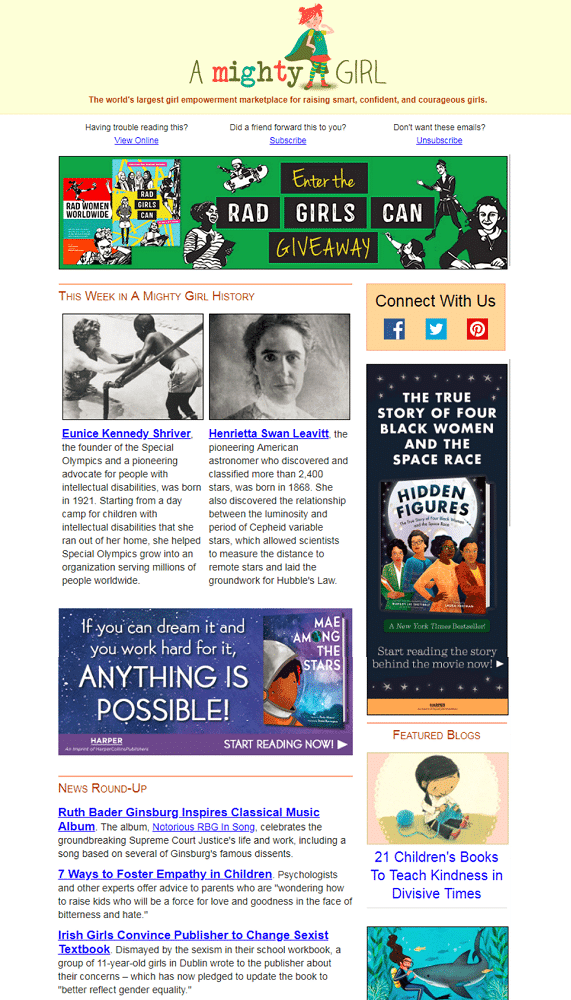
Even though their bread and butter comes from the items users buy on their website, notice how their email does not hard sell any item; instead focusing on content about powerful women in history, inspirational news items, content pieces that teach values to young girls – things that their typical user cares deeply about. Without a single “buy” button on their email, A Mighty Girl encourages its users to shop with them purely on the strength of the bond they’ve forged.
4. Use Familiarity to Your Advantage
My morning ritual consists of dashing out the door for work and stopping over at a neighborhood coffee shop for my morning cuppa. I prefer this small shop over a Starbucks for a very simple reason. I like to start my day with a smile, with people who know me, know what I like to drink without me even having to tell them. This level of familiarity and comfort is a privilege that is enjoyed by many small businesses. But are they making the most of it?
Make sure you offer a personal touch to all of your regular customers. A smile, a little chit-chat, helping them find a product, go a long way in putting your customer at ease and encouraging them to come in again for a similar warm experience.
When you know you your regular customers are and what they like, go the extra mile to offer them a product or service that is custom-made for them. Personal gestures like placing a special order for an item for a customer or offering to install a product in a customer’s home at no extra charge are all effective ways of knocking down walls and winning a customer for life!
If you’re an online-only business, though, you don’t have the luxury of a face-to-face tête-à-tête with your customers, don’t despair. Simple and inexpensive chatbots are within the reach of every small business willing to invest a little time and effort into online customer service.
5. Invest in Chatbots & Voice Tech
Businesses have been using AI to engage with customers and simplify or otherwise improve processes (and in doing so, drive sales) for a number of years now, and AI-powered chatbots which utilize pre-programmed scripts are definitely among the most effective tools. These nifty bots help to answer your web visitors’ queries, qualify sales leads and improve the basket journey for customers craving convenience and ease of use.
Chatbots are no longer just fancy FAQ machines equipped to answer basic queries. They are capable of interactive dialog at different touchpoints along the customer journey, as well as initiating and completing transactions with scalable, omni-channel functions. The easy availability of big data and simplification of AI programs has given bots the ability to personalize the experience for each shopper. The future belongs to mom-and-pop-and-bot stores!
Voice tech, of course, is even more sophisticated. Did you know, for instance, that you can tailor your special ‘virtual agent’ to speak in such a way as to align with your company’s brand? And if you suspect this is just fancy technology for fancy technology’s sake, you would be quite mistaken. AI-powered customer service meets burgeoning demand: a survey by Bright Local suggests that 58% of consumers have utilized voice search to locate local businesses in the past year.
All indications are that voice search, far from being a flash in the pan, is here to stay. And according to Emarketer, over 70 million Americans are using speech or voice recognition tech. So, optimizing your site content for voice search is something you should already have done. If not, start now.
If you’ve never given much thought to chatbots and voice technology, perhaps it’s time you mulled them over. Because these developing techs could help you improve your customer service and yield impressive ROI next year.
Both chatbots and voice AI have developed expeditiously in recent years, helping to resolve countless consumer queries without burdening or bogging down we fallible humans. Adding one or both to your arsenal will surely help to cut down on delays and furnish customers with the peace of mind and convenience they crave.
6. Prioritize Video Content
Video marketing is becoming more important, it seems, every day. Consider these stats:
- Twitter claims that 82% of its users view video content on the app.
- A HubSpot survey found that nearly half (45%) of individuals watch over an hour of video content on Facebook or YouTube each week.
You may be thinking, “Well, that’s social media – and social media isn’t my game.” But the trend is not exclusive to the realm of social channels. Online videos constitute over 80% of all consumer internet traffic. Just cogitate upon that for a second: more than four-fifths of internet traffic consists of videos.
Our expectations of what makes a satisfying browsing experience are changing. As a savvy business owner you would do well to respond to the flux of consumer expectations and deliver slick, professional video content that reinforces your brand and strikes a chord with your audience.
Not only will this keep you relevant in a fast-changing landscape, but it will get your message across more effectively. A research paper states that viewers retain 95% of a message when they observe it in a video – compared to just 10% when reading it in a text.
So yes, there might just be some utility in embedding a nicely-shot video to your product or category page, building up your YouTube channel and sharing relevant videos on social media. This includes live videos – which are growing in popularity – for breaking news or behind-the-scenes content.
You could spend all day reading surprising video marketing statistics, but you’d be better off addressing your aversion to stepping in front of the camera and making video a pillar of your strategy next year. Who knows, you might just be a natural!
Over to You
To recap, you can increase brand awareness and conversions at least in your local area with these marketing strategies:
- SEO improves your online visibility when potential customers search for your services on Google.
- Paid search is a great way to supplement SEO efforts and drive more traffic to your website.
- Email marketing allows you to stay top-of-mind with relevant customers.
- Social media keeps you connected with your customers and relevant in real-time.
- Content marketing helps you establish your thought leadership through credible materials.
While small businesses cannot outspend their large, established competitors, they can definitely charm the pants off their customers. Show prospects your vulnerable side, and you’ll soon be well on your way to replace the corporate business machine and win a customer for life. Remember, the vast majority of people prefer rooting for the underdog. A small business that does its job perfectly and serves that up with a huge dollop of genuine empathy can be held back by no business behemoth!
Unsure of how to get started with marketing as a small business? Schedule a free consultation to learn about our Weekly Blog Writing Services that make quality content seamless.

